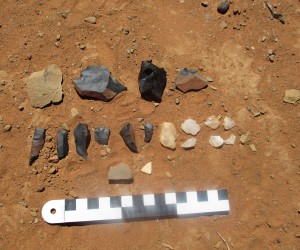The MeerKAT 64-dish array is a local project managed by the South African Radio Astronomy Observatory (SARAO). It is the pathfinder to the broader Square Kilometre Array (SKA) Project, which when complete will comprise in excess of 3000 linked radio telescopes across Africa and Australia. Following the inauguration of the MeerKAT radio telescope by the Deputy President of the Republic of South Africa, Mr David Mabuza (Read More), Digby Wells Environmental have finalised the Heritage Resources Management Process for SKA Phase 1 (Read More).
To promote compliance with the South African Regulatory Framework and international best practice standards, SARAO enlisted the services of Digby Wells to complete a Heritage Impact Assessment and cultural Conservation Management Plan for the SKA Phase 1 development footprint. This was a collaborative effort between technical experts in their field, representatives from the San Council, McGregor Museum and second year archaeology students from Sol Plaatje University.
Through extensive desktop research and in-field assessment of the site-specific study area, the cultural landscape comprises heritage resources ranging from palaeontological through to the historical period. Furthermore, the site-specific study area is situated within the /Xam Cultural Landscape. This area, along with the ≠Khomani Cultural Landscape was considered in the UNESCO Tentative World Heritage Site List because of its outstanding universal value. Tangible resources identified infield included examples of impressions of Calamites, Paracalamites, Glossopteris leaves and sphenophyte stems, lithic scatters from the Later Stone Age, Rock Art and vernacular corbelled houses. Consequently, it is believed the cultural landscape within which the SKA Project is situated, can be a catalyst and key point for affirming our national identity and character when we consider the landscape as a palimpsest of cultural layers.
Through completing the Heritage Resources Management Process, SARAO and Digby Wells have acknowledged and reaffirmed the importance of protecting our heritage. Presently, the generated documentation is available to the public on our website and the South African Heritage Resources Information System (SAHRIS). We encourage you to explore the fascinating heritage of this region of the Northern Cape.






